|
|

|
Porsche, and the Porsche crest are registered trademarks of Dr. Ing. h.c. F. Porsche AG.
This site is not affiliated with Porsche in any way. Its only purpose is to provide an online forum for car enthusiasts. All other trademarks are property of their respective owners. |
|
|
 Model Specific Information
Model Specific Information
914/4: 70 71 72 73 74 75 76 914/6: 70 71 72
  |
| wonkipop |
 Apr 3 2024, 03:06 PM Apr 3 2024, 03:06 PM
Post
#41
|
|
914 Guru      Group: Members Posts: 5,302 Joined: 6-May 20 From: north antarctica Member No.: 24,231 Region Association: NineFourteenerVille 
|
Checking a few archives: The center gauge console was first offered for the 1973 2.0L and only the 2.0L. I am sure a dealer could get the needed parts and install it in any 914 as has been done many times over the years. See page 19. https://bowlsby.net/914/Classic/zMan_1973_S...iningManual.pdf The targa vinyl became standard on all 914s (except the USA LE cars and apparently the 1.8L ROW market cars) beginning with the 1974 model year. Interestingly (to me anyway) the 1974 914GT (German market LE) had the vinyl, yet the 914SL (Japan market) did not. Its my understanding that Porsche designers wanted to make these limited edition cars in their various markets, be stylistically different from the standard model year cars. See page 5. https://bowlsby.net/914/Classic/zMan_1974_2...iningManual.pdf makes sense re german market GT. from the few genuine euro market 1.8s i have dug up all were no vinyl. even one 75 that had a gauge/console. almost as if german or european taste was headed towards back trim and no vinyl and away from chrome at that time. divergent from USA taste. thanks for confirming my file info on the 74 on USA 1.8s i used to know an old german VW mechanic here who i think is still alive. its been years since i have seen his 2 914s but i believe he still has them. one was a last of the line german 75 2.0 i can recall it well. no vinyl targa bar. but it had guages and console. it was an original car in excellent condition that he inported in to aus from germany way back. late 70s or early 80s i recall. i should go out and see him before its too late and see if can get some photos of it. |
| wonkipop |
 Apr 3 2024, 03:25 PM Apr 3 2024, 03:25 PM
Post
#42
|
|
914 Guru      Group: Members Posts: 5,302 Joined: 6-May 20 From: north antarctica Member No.: 24,231 Region Association: NineFourteenerVille 
|
Does anyone have an idea of how many cars were optioned with the center seat belt.?? And I suppose it would show up on a COA..?? never seen an example. none in all the L jet cars i trawled through. don't recall seeing attachment points either when i last had interior of mine out 4 or 5 years back. maybe they were there but i sure didn't notice them. was the 914 ever officially a three seater for USA DOT certification. from memory the tyre pressure sticker on the gas tank of my 74 914 notes "Seating Positions 2". |
| gandalf_025 |
 Apr 3 2024, 05:06 PM Apr 3 2024, 05:06 PM
Post
#43
|
|
Senior Member    Group: Members Posts: 1,510 Joined: 25-June 09 From: North Shore, Massachusetts Member No.: 10,509 Region Association: North East States |
From what I understand the center belt was only offered on early cars.
The 2+1 seating sticker has been shown in another thread.. 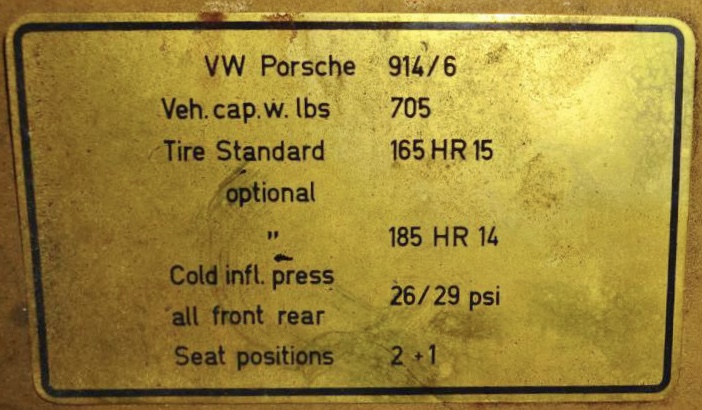 |
| JeffBowlsby |
 Apr 3 2024, 08:26 PM Apr 3 2024, 08:26 PM
Post
#44
|
|
914 Wiring Harnesses & Beekeeper      Group: Members Posts: 9,144 Joined: 7-January 03 From: San Ramon CA Member No.: 104 Region Association: None 
|
Center seatbelts were optional equipment M166 (US cars) and M186 (ROW cars) https://bowlsby.net/914/Classic/OpEq.htm Center seatbelts were available for all cars from at least 1971-on. Per the link above. |
| mepstein |
 Apr 3 2024, 08:43 PM Apr 3 2024, 08:43 PM
Post
#45
|
|
914-6 GT in waiting                Group: Members Posts: 20,295 Joined: 19-September 09 From: Landenberg, PA/Wilmington, DE Member No.: 10,825 Region Association: MidAtlantic Region 
|
I’ve only seen center belts in early cars and my understanding is that only early cars had the welded mount for them. The center belt that I just sold came from an early ‘70 that I parted out and cut up. It was a one owner car (before me) but too far gone to repair. Some neat first year only details on that car. Metal round relays, two piece door cards, etc. u would have liked to save it but besides the normal east coast rust, there were panels that couldn’t easily be repaired. The front shock towers were rusted out.
The interesting thing was the original owner drove the car to work in the same town where I grew up. I even rode my bike past his workplace parking lot when I was training. Bought his car 35 years later. |
| wonkipop |
 Apr 3 2024, 09:42 PM Apr 3 2024, 09:42 PM
Post
#46
|
|
914 Guru      Group: Members Posts: 5,302 Joined: 6-May 20 From: north antarctica Member No.: 24,231 Region Association: NineFourteenerVille 
|
I’ve only seen center belts in early cars and my understanding is that only early cars had the welded mount for them. The center belt that I just sold came from an early ‘70 that I parted out and cut up. It was a one owner car (before me) but too far gone to repair. Some neat first year only details on that car. Metal round relays, two piece door cards, etc. u would have liked to save it but besides the normal east coast rust, there were panels that couldn’t easily be repaired. The front shock towers were rusted out. The interesting thing was the original owner drove the car to work in the same town where I grew up. I even rode my bike past his workplace parking lot when I was training. Bought his car 35 years later. good to know. did not think i was imagining there were no mounts for those belts in my 74. interesting how that sticker changes from the 70-72 cars and is 2 seat only from 73 on. that had to have been a DOT thing. i think i know why. had to bone up on 73 1.7s. checked the ones in my file. seat belt interlock relay. somehow i thought that came in with 74s, but i see its got the interlock light on the dashboard of the 73 1.7s i have on file. it would have been a horror to incorporate the seat belt interlock into the removable seat cushion of the so called third seat. bad enough it was hooked up to two seats. throw something down on the cushion or even lean on with your elbow and the whole buzzer bs ignition no no shebang would have gone off. (IMG:style_emoticons/default/biggrin.gif) (IMG:style_emoticons/default/biggrin.gif) (IMG:style_emoticons/default/biggrin.gif) @JeffBowlsby -i think whatever the option sheet data might have said about it being an option for all cars all years might have been thrown out the window in the USA after 72 due to DOT interlock design rules. |
| JeffBowlsby |
 Apr 3 2024, 10:16 PM Apr 3 2024, 10:16 PM
Post
#47
|
|
914 Wiring Harnesses & Beekeeper      Group: Members Posts: 9,144 Joined: 7-January 03 From: San Ramon CA Member No.: 104 Region Association: None 
|
@JeffBowlsby -i think whatever the option sheet data might have said about it being an option for all cars all years might have been thrown out the window in the USA after 72 due to DOT interlock design rules.
[/quote] I dunno. The center seat belt mounting brackets can be bolted thru the seatbelt receiver bolts on the later cars. I had it that way in my 74 for awhile. No issues. The price sheets I documented were German market cars...maybe the center seat issue did not apply there? In 73 it was a "Seatbelt Warning System". Just a dumb 'sit on the passenger seat without being buckled up, and the dash light lights, and a buzzer sounds'. 74-76 it was the "Seatbelt interlock system" that disables the car from starting if not buckled up. The center seatbelt had no sensors, it was just a convenience for when your honey wanted to snuggle up. |
| wonkipop |
 Apr 4 2024, 01:16 AM Apr 4 2024, 01:16 AM
Post
#48
|
|
914 Guru      Group: Members Posts: 5,302 Joined: 6-May 20 From: north antarctica Member No.: 24,231 Region Association: NineFourteenerVille 
|
[quote name='JeffBowlsby' date='Apr 3 2024, 10:16 PM' post='3137748']
@JeffBowlsby -i think whatever the option sheet data might have said about it being an option for all cars all years might have been thrown out the window in the USA after 72 due to DOT interlock design rules. [/quote] I dunno. The center seat belt mounting brackets can be bolted thru the seatbelt receiver bolts on the later cars. I had it that way in my 74 for awhile. No issues. The price sheets I documented were German market cars...maybe the center seat issue did not apply there? In 73 it was a "Seatbelt Warning System". Just a dumb 'sit on the passenger seat without being buckled up, and the dash light lights, and a buzzer sounds'. 74-76 it was the "Seatbelt interlock system" that disables the car from starting if not buckled up. The center seatbelt had no sensors, it was just a convenience for when your honey wanted to snuggle up. [/quote] aha - the 73 version sounds a bit more harmless than the 74. that seatbelt interlock and its relay caused me a lot of pain 30 years ago. i was very happy when i had it taken out of circulation. (IMG:style_emoticons/default/biggrin.gif) (IMG:style_emoticons/default/biggrin.gif) hey i have thought about that wiring loom you mentjoned with capacity for guages in 73 and the penny dropped while i was taking a train ride to one of my job sites today. i think you might have just explained why the 1,7 engines only have two painted code numbers on them in contrast to the 4 codes on the 1.8 engines in 74 and 75. i'll post the theory later after i have reduced it in words to something simple. but you got my brain turning it over and i have had a light bulb moment. might be a mad lightbulb moment but it did light up. (IMG:style_emoticons/default/biggrin.gif) (IMG:style_emoticons/default/biggrin.gif) (IMG:style_emoticons/default/biggrin.gif) (IMG:style_emoticons/default/beerchug.gif) (IMG:style_emoticons/default/beer.gif) |
| wonkipop |
 Apr 4 2024, 03:47 PM Apr 4 2024, 03:47 PM
Post
#49
|
|
914 Guru      Group: Members Posts: 5,302 Joined: 6-May 20 From: north antarctica Member No.: 24,231 Region Association: NineFourteenerVille 
|
I'm still processing the above, but here are a couple of other fun facts to ponder: The 1971 wiring schematic includes an oil temp sender circuit on the ignition harness and the original ignition harnesses have this circuit. The 1970 and 1972 do not. My thinking is that a separate wire directly connected the 1971 ignition harness to a sump mounted oil temp sender. Unlike the later 73-76 cars with the circuitry in the main chassis harness. The 1973-76 cars have the center console gauge harness connections in the main chassis harness under the carpet, the 1970-72 cars do not. ok @jeffBowlsby - returning to this. (this thread has been good. wandering further north of the seat cushion into the package bin along with this info on the harness of the 73-76 cars might throw a bit of light on the last mystery i was trying to find data on re three number engine code stamps on the 4 cylinders). i got to here. 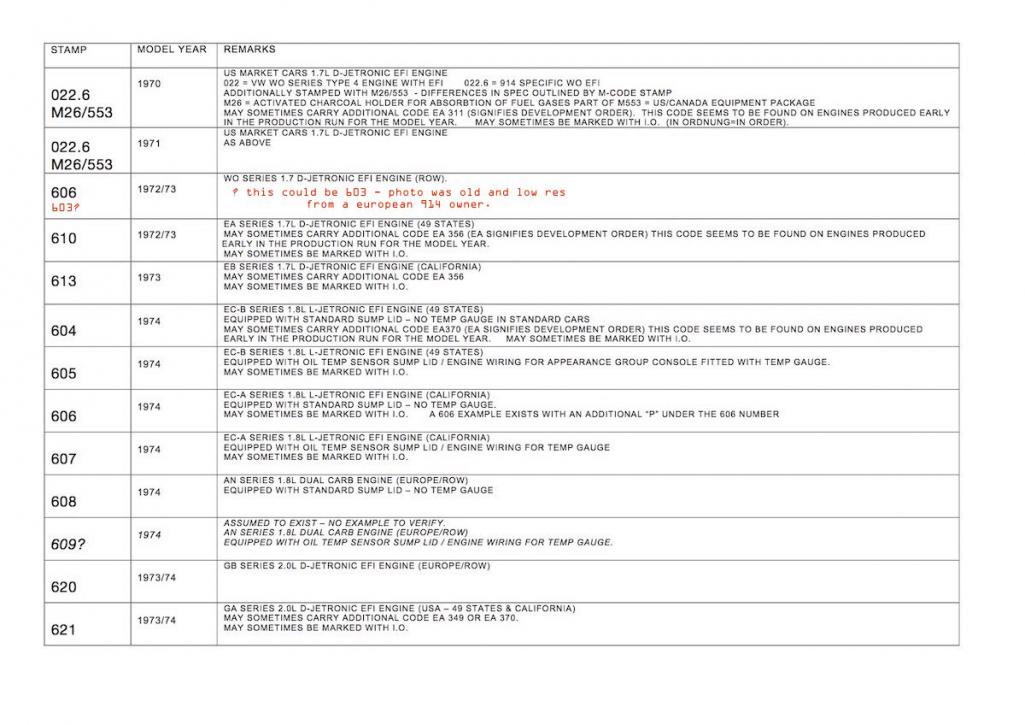 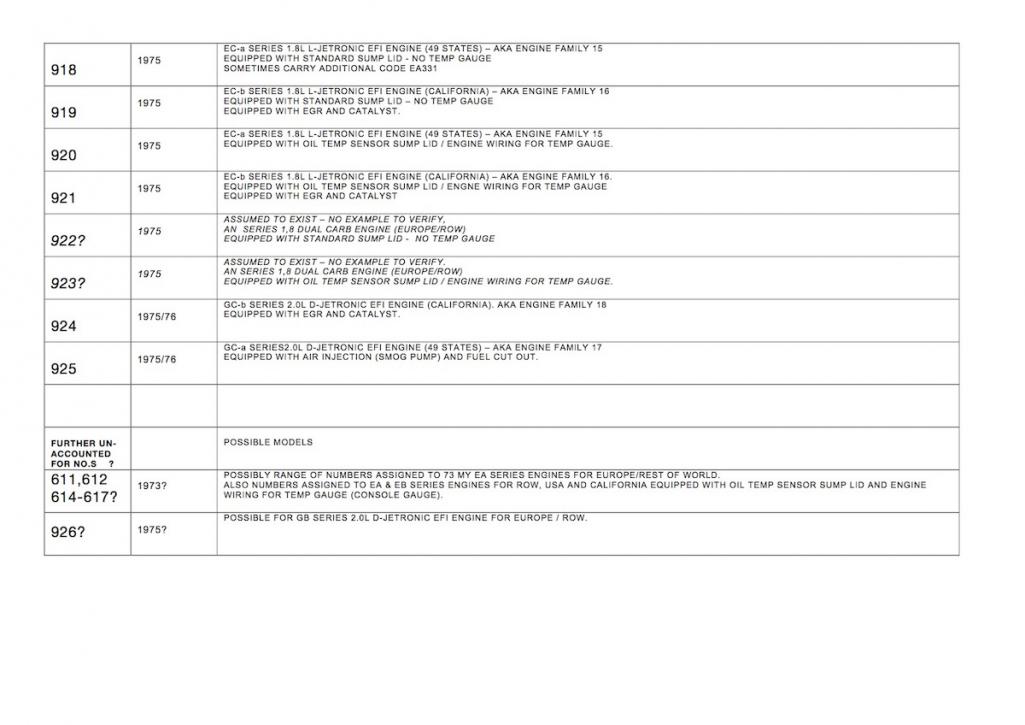 as you may recall Jeff we were initially only restricting research to 74 1.8 L jet cars. we started turning up enough examples of the engine stamp codes to pretty much capture the extent of them. and there was a verifiable pattern. there were 4 number codes present on north american engines. they corresponded to first of all whether a 49 states engine or california. and further subdivided into whether it was a car built as an appearance group 1.8 or a base 1.8. if appearance group (fitted with gauge + console) the engine was also assembled and supplied by engine factory at hanover with a sump plate with oil temp sensor and engine wiring to plug directly into the chassis wiring loom. using PET we worked out that the 1.8 engines have listed the two types of sump plate as fitted. whereas 2.0 engines always were fitted with sump plate with sensor and wiring. what also became clear was that in 74 all 1.8s got as part of what we call appearance group package with the same guage and console as the 2.0 cars. in fact the 1.8s were pretty much the same as 2.0 appearance group optioned car, just gave you the choice of it being the smaller engine (fuel economy, first oil crisis? scenario). after that 74 1.8 engine research i extended the collection of data into the 75 1.8s. 75s used a very similar spread of 4 letter codes across a sequential range of 4 consective numbers. i got all those codes and connected them to verified data (original window stickers). a repeat of 74 data in terms of what type of engine was numbered with which number. similarly 75 1.8s also repeat the 74 spec re appearance group and base car. after the 75s i went into the 73 1.7s. i figured if my theory was right there ought to be also 4 of these codes for the 1.7 engines in 73. 1 for base EA (49 states), for appearance group EA, 1 for base EB (California) and 1 for a. g. EB. but i have only ever been able to find 2 engine stamp numbers for the 73 1.7 610 for the EA 613 for the EB. but now i can see the assumption i got wrong. its clear to me now the 1.7 appearance group cars were not fitted with a console and guages as a factory spec option set up. only the 73 2.0s. the 1,7s got a parcel bin console. VW-Porsche kept a bit of spec difference to distinguish the two different engined cars in 1973. likely a marketing strategy? but there was a four consecutive range of numbers alocated to the 1.7s. running from 610 to 613. the wiring loom you say exists in all 73 cars and can take the temp sensor connection from the engine along with the 4 number range allocated indicates to me that VW-Porsche contemplated offering the guage+console in the 73 1.7s for appearance group. to do this they would have used all 4 of the numbers just as they did in 74 and 75. however a late decision was made i think and they changed strategy. as a result they simply used the first and last code number possibilities from the allocated range of 3 number codes. 610 for EA and 613 for EB. i conclude there is no 611 or 612 engines. they dropped the necessity for these late in their plans for 73 models. -------- another curiousity of these code combinations is as follows. the EC 1.8 engines come after the EA and EB 1,7 engines chronolgically. yet when you look at the code allocations. the EC engines have the 600-609 range. the EA/EB engines have the 610-619 range. and the G engines have the 620 range. which almost suggests that in terms of engine design projects that the EC precedes the EA/EB. which it might have. thats what i am thinking. negotiations with the EPA by all the big car manufacturers in 1972 caused the program for emissions standards introductions to be be delayed one year and shifted in time. kind of opening up an interim year in 1973. i think the EA and EB engines of 73 were a late insertion into the development program of the 914 and the EC engines were given more time to be developed - in particular focussing on the new L jetronic injection system. that is probably why they get their own 10 range of 3 number codes? --------- thats why i think the wiring loom is there in the 73 1.7s but never the possibility of the temp gauge (at least from the factory as an ordered car). in fact i am yet to come across a verifiable 1.7 fitted with the temp gauge from factory. enough examples come up with a console and gauge but these are not original condition cars you can use to verify data. --------- after 73 it looks to me like VW-Porsche go ahead with their planned model strategy given thought to earlier. ie that the appearance group versions of the 1.8s and 2.0s are very similar (almost identical spec) cars only distinguished by their engine types as the difference. -----or its all about fuel economy versus power. apart from that you can have the same car if you wish. |
| wonkipop |
 Apr 4 2024, 04:13 PM Apr 4 2024, 04:13 PM
Post
#50
|
|
914 Guru      Group: Members Posts: 5,302 Joined: 6-May 20 From: north antarctica Member No.: 24,231 Region Association: NineFourteenerVille 
|
i've also worked out some details of my car and its original purchase from the discussions in this thread and confirmation by @JeffBowlsby re spec of the base 74 and 75 1.8
in all the documentation that came with my car 35 years ago, a window sticker was missing. so can never confirm the factory order spec. but it might be time for me to talk to @davep (IMG:style_emoticons/default/biggrin.gif) however there were two 73 brochures. one is a big brochure and the other is the fabric and paint phamplet. the brown interior is ticked. my car has a brown interior. and on the ext colors page is handwriting that says "which paint color?" same handwriting as in some pages of glove box manual. #1 is summer yellow. #2 is signal orange. my car is phoenix red. i conclude the original owners were looking at a car in 1973 and made the decision to place an order and buy in 74. they were probably looking at a 73 1,7 appearance group in the showroom? and now i know a base 1,8 in 74 was pretty close in most ways to an appearance group 1,7 in 73. all that was missing was the parcel bin! - pretty much. probably explains the parcel bin in mine? deliberate request and must have been a stronger preference to them than guages and console of the 74 1.8 A.G. its unsual. i have only stumbled across one or two other 74 1.8s with the package bin. nearly all are either nothing or the A.G console/guage set up. they also special ordered in the sway bars. looks to me like nothing else. just a base 18 with the bin and the sway bars. like you did not have to do much to a base 1.8 in 74 to have a car virtually identical to a full spec 1.7 from 73. pretty clear that one thing the original owners agreed on as husband and wife was it had to have a brown interior. very 1974 fashion/taste. the husband i bought the car off said it was his late wife's car. she had kept it and would not part with it. i reckon she might have been the one who was specific about the parcel bin? its an early L jet from the first 3 months of production. so its on the cusp of the end of 73s being in the showroom and the first arrival of the batch of new models coming in. |
| wonkipop |
 Apr 5 2024, 01:46 AM Apr 5 2024, 01:46 AM
Post
#51
|
|
914 Guru      Group: Members Posts: 5,302 Joined: 6-May 20 From: north antarctica Member No.: 24,231 Region Association: NineFourteenerVille 
|
here is a mission for you @JeffBowlsby .
its to do with LEs. it might get one more engine stamp number. for 1974 all USA 2.0s were GA engines with 621 stamp. (low comression 7.6 : 1, 95 hp.) European 2.0s were GB engines with 620 stamp. (high comression 8.0:1, 100 hp). but japan definitely the high compression engine. 8.0:1. and japan had introduced the vapor emission system. (along with australia). europe did not have vapor emission system. so its a unique engine. euro compression internals and vapor emission system. see images below. matsuda 914 engine bay has the can in it like all usa 74s. which meant it had to have a drilled out fan casting with the inset sleeved tube to take the blower bleed hose to the charcoal cannister. euro cars did not have that. and given the engines were built in hanover that meant it had to be built that particular way and identified so the correct engine was delivered at osnabruk and put in the right car on the assembly line. i'm betting that matsude 914 that @dr914 has in his collection has neither 620 or 621 stamped on it. ie it won't have a ROW number on it just because its not a USA engine. but it will be likely in the 62....X range. maybe 622? maybe you can find out? its interesting in terms of LE information and more broadly. (it means there would have been a range of J spec engine stamp code numbers because they are all euro spec internals with USA vapor emission provision on the blower casting). it will be further evidence for my theory on engine stamp numbers. remembering its only a theory. (IMG:style_emoticons/default/biggrin.gif) 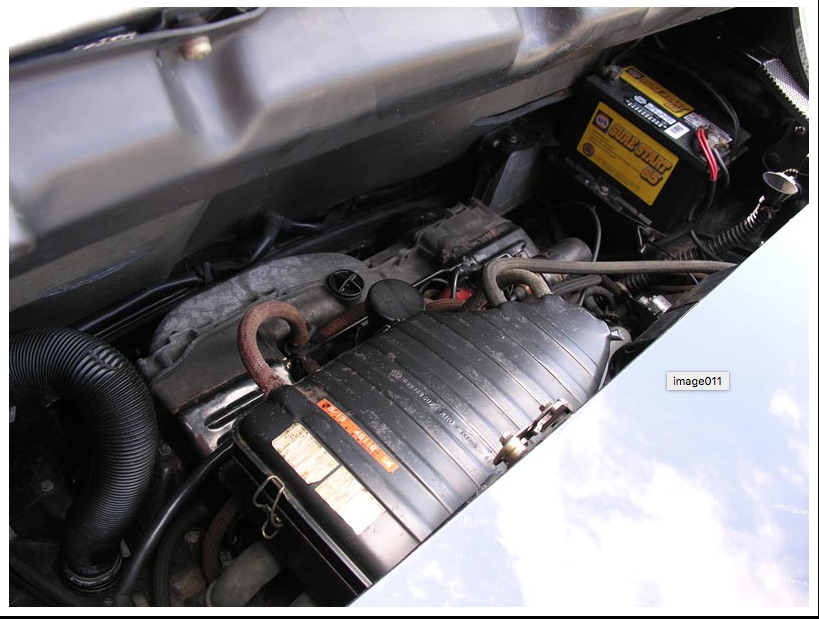 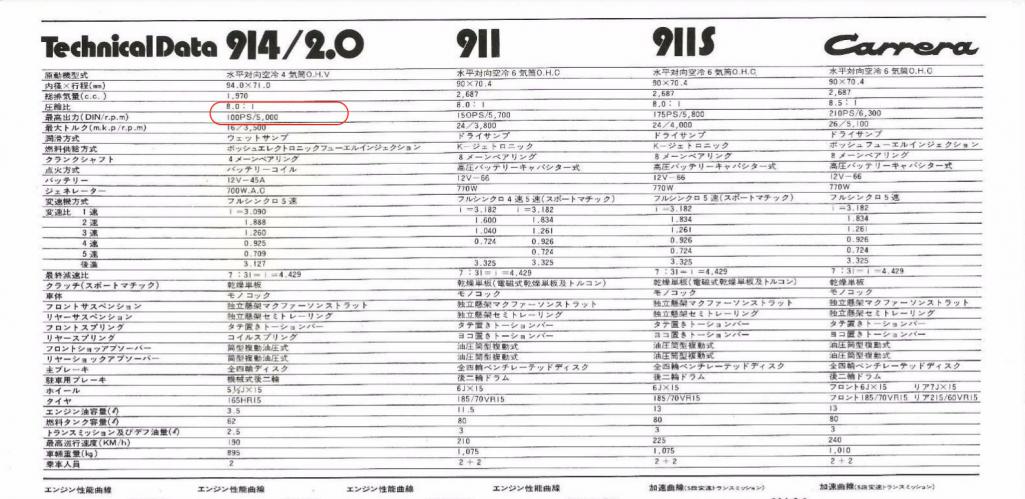 |
| JeffBowlsby |
 Apr 6 2024, 09:26 PM Apr 6 2024, 09:26 PM
Post
#52
|
|
914 Wiring Harnesses & Beekeeper      Group: Members Posts: 9,144 Joined: 7-January 03 From: San Ramon CA Member No.: 104 Region Association: None 
|
NICE. Verifying the engine tin number on the Matsuda Bumblebee would be in @dr914 wheelhouse.
|
| wonkipop |
 Apr 7 2024, 04:20 PM Apr 7 2024, 04:20 PM
Post
#53
|
|
914 Guru      Group: Members Posts: 5,302 Joined: 6-May 20 From: north antarctica Member No.: 24,231 Region Association: NineFourteenerVille 
|
i'm inaccurate saying the 2.o has the fan casting drilled. that would only be the 1.7/1.8 euros that don't have that and J spec do. instead its the nipple on the left hand side tin for a 2.0. nevertheless the euro 2.0 does not have nipple on the tin. so the J spec 2.0 engine has to be a combo of USA tin and Euro higher compression internals (8:1) rather than USA internals (7.6:1) there are no J spec 74/75 1.8s. only 2.0s sold there those years. but there were J spec 73 1.7s. they seem to have slightly higher hp equal to euro spec. so likely the J spec 1.7s in 73 also had a dedicated stamp number for evap bleed off fan casting but euro internals or EFI set up tuning rather than USA spec. i got tantilisingly close to the number on the 75 euro 2.0 with a car for sale in germany. there have been a number of excellent condition 2.0s for sale in germany recently, we know the USA 75 2.0s take 924 and 925. and whatever the euro one is its either taking up 922 or 923 or a number sequence after 925. might stumble on the number one day. 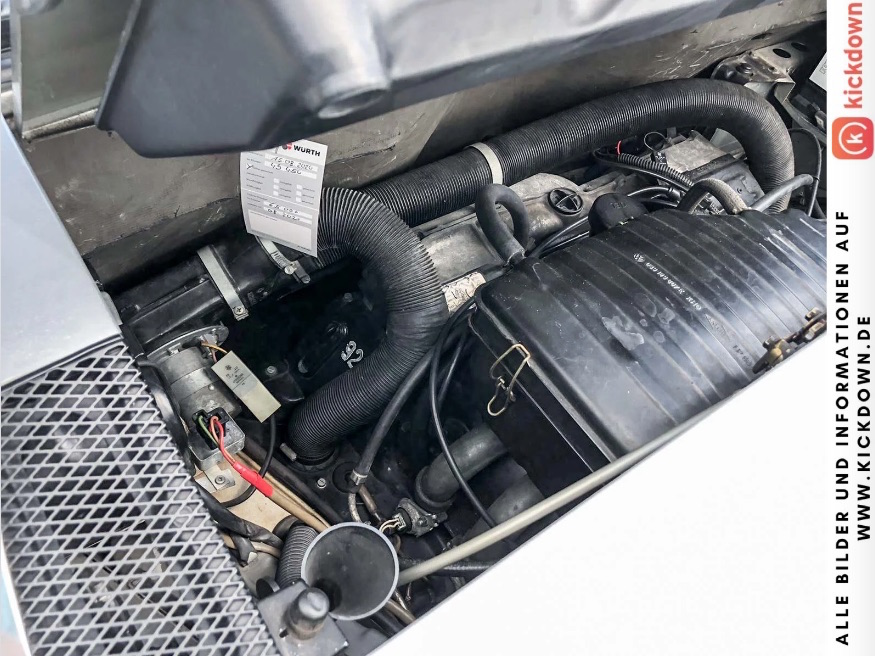 |
| wonkipop |
 Apr 7 2024, 04:33 PM Apr 7 2024, 04:33 PM
Post
#54
|
|
914 Guru      Group: Members Posts: 5,302 Joined: 6-May 20 From: north antarctica Member No.: 24,231 Region Association: NineFourteenerVille 
|
i'm pretty sure its 74 that australia introduces the charcoal cannister evap system as a design rule. and......thats the reason you could not privately import post 73 model 914s. the two crayfords cars that came in were 73 models and a note was made in an australian motor magazine test/review that the car they were testing would be the last as 74s were no longer permissable. japan is either at the same time ---- 74 model year or a year earlier in 73. so i'm not entirely sure if 73 J spec cars got evap.
but 74 models definitely did. |
| wonkipop |
 Apr 9 2024, 03:29 PM Apr 9 2024, 03:29 PM
Post
#55
|
|
914 Guru      Group: Members Posts: 5,302 Joined: 6-May 20 From: north antarctica Member No.: 24,231 Region Association: NineFourteenerVille 
|
found out a little bit more on japanese and australian emissions regulations.
australia introduced ADR27 for calendar year cars 1974. japan had very similar standards in place for calendar year 1973. both countries modeled the standards (reg) very much based on USA emissions standards that had commended in 1970 calendar year (ie late 70MY early 71MY usa market cars). cars for japan and australia were to be equipped with evap system, closed crankcase ventilation systems (pcv) and also meet tailpipe emissions for set standards of NOX, HCPPM and CO. the important distinction was that neither japan or aust had a tight time line set for unleaded fuel introduction. in australia's case that does not come into effect until 1984. not sure on japan deadline date but its sometime well after 1973. hence cars for japan (and theoretically aus) could retain high compression engines running on higher octane leaded. it was unleaded fuel that caused the primary drop in performance in USA market cars as compression ratios had to be lowered. so - a J market 73 car had to have PCV, EVAP System and meet tailpipe emissions probably very similar to USA 71MY cars. i haven't found a 73 J market car with sufficient documentation in original condition to verify the EVAP system inclusion. however its clear from @dr914 's limited documentation that the matsuda 74 LE does have it. its also an insight into why misawa might have dropped the 1.8 from its imported range in 1974. at that point the ROW 1.8 was a twin carb high compression motor with no emissions gear tailored for euro market. it would have been extremely unlikely that it could have passed 73 J tailpipe emissions in its euro form. as an alternative the L jet 1.8 was an unleaded fuel car well down on power. so they just gave up on that one? the 2.0 L euro high compression engine would have been tweakable on tailpipe emissions standards yet still have retained its higher euro power due to higher compression. its also the explanation for the 73MY cutoff for crayfords rhd converted cars for private import into aus. the crayfords business model was in alliance with malaya motors UK and cars were UK spec cars set up for UK regs (headlights, etc). as such did not meet ADR27. no EVAP and likely non compliance with tailpipe emissions = end of the road for a private import RHD 914 for australia. (note cars had to be RHD in aust). |
  |
1 User(s) are reading this topic (1 Guests and 0 Anonymous Users)
0 Members:

|
Lo-Fi Version | Time is now: 20th December 2025 - 09:36 PM |
Invision Power Board
v9.1.4 © 2025 IPS, Inc.









